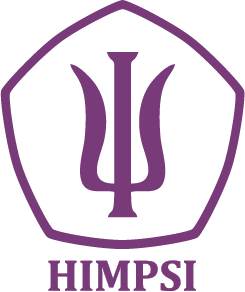HUBUNGAN ANTARA WAKTU KERJA DAN KETERLIBATAN AYAH
DOI:
https://doi.org/10.25170/manasa.v11i2.3841Abstract
Paternal involvement is necessary for children ages 6-12 to thrive optimally. On the other hand,
fathers face a challenge of having limited time to spend with their children as a result of being a
breadwinner to fulfil the family’s needs. This research aimed to identify the relationship between
the time fathers spent at work and the paternal involvement of fathers with children ages 6-12
years old. This was quantitative research with a correlational design. There were 50 fathers with
children between the ages of 6-12, currently working, and living in Jabodetabek as participants.
Father’s paternal involvement was measured using the Paternal Involvement Questionnaire. The
time fathers spent working were collected using a time sheet. Participants recorded their daily
activities within a 30-minute interval for 7 days. The hypothesis was tested using the Spearman
correlation test which showed that there was no significant relationship between the time fathers
spent at work and the paternal involvement of fathers with children ages 6-12 years old. This result
indicated that even if fathers spent more time working, this doesn’t mean they have lower paternal
involvement than fathers who spent less time working. For future research, it is recommended to
investigate further the relationship between father involvement, father's location of work, father's
assistance in taking care of children, and maternal gatekeeping.
References
As’yari, H., & Ariyanto, A. (2019). Gambaran keterlibatan ayah dalam pengasuhan anak (paternal involvement) di Jabodetabek. Intuisi Jurnal Psikologi Ilmiah, 11(1), 37-44. DOI: 10.15294/intuisi.v11i1.20115
Ayah Asi. (2020). diambil dari https://ayahasi.org/
Bartlett, J., Kotrlik, J., & Higgins, C. (2001). Organizational research: Determining appropriate sample size in survey research. Information Technology, Learning and Performance Journal 19(1).
Bonney, J., Kelley, M., & Levant, R. (1999). A model of fathers' behavioral involvement in child care in dual-earner families. Journal of Family Psychology, 13(3), 401–415. https://doi.org/10.1037/0893-3200.13.3.401
Cabrera, N., Fitzgerald, H., Bradley, R., & Roggman, L. (2014). The ecology of father-child relationships: An expanded model. Journal of Family Theory & Review, 336-354. DOI:10.1111/jftr.12054
Cohen, R., & Swerdlik, M. (2018). Psychological testing and assessment: An introduction to tests and measurement. McGraw-Hill Education.
Coverman, S. (1985). Explaining husbands' participation in domestic labor. The Sociological Quarterly, 26(1), 81-97. https://doi.org/10.1111/j.1533-8525.1985.tb00217.x
Craig, L., Powell, A., & Cortis, N. (2012). Self-employment, work-family time and the gender division of labour. Work, Employment and Society, 25(7), 716-734. https://doi.org/10.1177/0950017012451642
Creswell, J. (2012). Educational research: Planning, conducting and evaluating quantitative and qualitative research. Boston: Pearson Education
Crocker, L., & Algina, J. (2008). Introduction to classical and modern test theory. Cengage Learning.
Dannisworo, C., & Amalia, F. (2019). Psychological well-being, gender ideology, dan waktu sebagai prediktor keterlibatan ayah. Jurnal Psikologi, 46(3), 241-260. DOI: 10.22146/jpsi.35192
Doinita, N. & Maria, N. (2015). Attachment and parenting styles. Procedia: Social and Behavioral Sciences, 199-204.
Fong, M., & Brainbridge, H. (2016). Working fathers: Determinants of time allocation to work and family roles. Labor & Industry, 26(3), 203-219. DOI:10.1080/10301763.2016.1214797
Gauthier, A., & DeGusti, B. (2012). The time allocation to children by parents in Europe. International Sociology, 27(6), 827-845. https://doi.org/10.1177/0268580912443576
Gravetter, F., & Wallnau, L. (2015). Statistics for the behavioral sciences. New York: Cengage Learning.
Grolnick, W. (2002). The psychology of parental control: How well-meant parenting backfires. New Jersey: Lawrence Erlbaum Associates.
Hiller, D. (1984). Power dependence and division of family work. Sex Roles, 10. DOI:10.1007/BF00288521
Hofferth, S., Pleck, J., Stueve, J., Bianchi, S., & Sayer, L. (2008). The demography of fathers: What fathers do. In C. LeMonda, Handbook of Father Involvement (pp. 63-90). New Jersey: Lawrence Erlbaum Associates.
Kaplan, R. M. & Sacuzzo, D. P. (2009). Psychological Testing: Principles, Applications, and Issues (7th ed.). Cengage Learning
KBBI. (2021). Ayah. dalam https://kbbi.kemdikbud.go.id/entri/ayah
Keluarga Kita. (2021). diambil dari https://keluargakita.com/
Lamb, M. (2008). Infant-father attachments and their impact on child. Dalam C. LeMonda, Handbook of Father Involvement (pp. 93-118). New Jersey: Lawrence Erlbaum Associates.
Lamb, M. (2010) How do fathers influence children’s development? Let me count the ways, The Role of the Father in Child Development (pp. 1-26). John Wiley & Sons, Inc.
McLaughlin, K., & Muldoon, O. (2014). Father identity, involvement and work-family balance: An in-depth interview study. Journal of Community & Applied Social Psychology. DOI:10.1002/casp.2183
Memon, M., Ting, H., Cheah, J., Thurasamy, R., Chuah, F., & Cham, T. (2020). Sample size for survey research: Review and recommendations. Journal of Applied Structural Equation Modeling, 4(2). DOI: 10.47263/JASEM.4(2)01.
Menteri Ketenagakerjaan Republik Indonesia. (2021). Keputusan Menteri Ketenagakerjaan Republik Indonesia No.104 Tahun 2021: Menteri Ketenagakerjaan Republik Indonesia.
Milkie, M., & Peltola, P. (1999). Playing all the roles: Gender and the work-family balancing act. Journal of Marriage and Family, 61(2), 476-490. https://doi.org/10.2307/353763
Miller, L., & Lovler, R. (2020). Foundations of psychological testing: A practical approach. California: SAGE Publications.
Mishra, P., Pandey, C., Singh, U., Gupta, A., Sahu, C., & Keshri, A. (2019). Descriptive statistics and normality tests for statistical data. Annals of Cardiac Anasthesia, 22(1), 67-72.
Palkovitz, R. (2008). Involved fathering and child development: Advancing our understanding of good fathering, Handbook of Father Involvement (119-140). New Jersey: Lawrence Erlbaum Associates.
Parke, R., McDowell, D., Kim, M., Killian, C., Dennis, J., Flyr, M., & Wild, M. (2008). Fathers' contributions to children's peer relationships. Dalam C. LeMonda, Handbook of Father Involvement (pp. 141-168). New Jersey: Lawrence Erlbaum Associates.
Partasari, W. D & Lentari, F. R. M. (2014). Keterlibatan ayah dalam pandangan ayah dan anak: Studi terkait dengan penyesuaian perkawinan dan kesejahteraan psikologis. Laporan penelitian. Tidak dipublikasikan. Jakarta: Universitas Katolik Indonesia Atma Jaya.
Partasari, W., Lentari, F., & Priadi, M. (2017). Gambaran keterlibatan ayah dalam pengasuhan anak usia remaja (usia 16-21 tahun). Jurnal Psikogenesis, 5(2), 159-167. DOI:10.24854/jps.v5i2.504
Pedersen, D., & Kilzer, G. (2014). Work-to-family conflict and the maternal gatekeeping of dual-earner mothers with young children. Journal of Family and Economic Issues, 251-262. DOI 10.1007/s10834-013-9370-3
Pemerintah Indonesia. (2003). Undang-Undang Nomor 13 Tahun 2003 tentang Tenaga Kerja. Jakarta
Pemerintah Indonesia. (2020). Undang-Undang Nomor 11 Tahun 2020 tentang Cipta Kerja. Jakarta
Pemerintah Indonesia. (2021). Peraturan Pemerintah Nomor 35 Tahun 2021. Jakarta
Pemerintah Indonesia. 2020). Peraturan Pemerintah Republik Indonesia No.21 Tahun 2020. Jakarta
Perruci, C., Potter, H., & Deborah, R. (1978). Determinants of male family-role performances. Psychology of Women Quarterly, 3(1), 53-66. https://doi.org/10.1111/j.1471-6402.1978.tb00525.x
Pleck, J. (1997). Paternal involvement: Levels, sources, and consequences. Dalam The Role of the Father in Child Development (66-103). New York: John Wiley & Sons, Inc.
Pleck, J. (2010). Paternal involvement: Revised conceptualization and theoretical linkages with child outcomes. Dalam The Role of the Father in Child Development (pp. 67-107). Wiley.
Prawiro, F. (2021). Panduan Penulisan Skripsi. Jakarta: Penerbit Universitas Katolik Indonesia Atma Jaya.
Prichilia, F. (2018). Komunitas Bapak Rangkul: Mengasuh Anak Tak Cuma Tugas Ibu. Diambil dari https://kumparan.com/kumparanmom/komunitas-bapak-rangkul-mengasuh-anak-tak-cuma-tugas-ibu-1542438370427675741/full
Privitera, G. (2018). Statistics for the behavioral sciences. California: SAGE Publications.
Roggman, L., Fitzgerald, H., Bradley, R., & Raikes, H. (2008). Methodological, measurement, and design issues in studying fathers: An interdisciplinary perspective. Dalam Handbook of Father Involvement (1-29). New Jersey: Lawrence Erlbaum Associates.
Santrock, J. (2013). Life-span development. Texas: McGraw Hill Education.
Sayer, L., Bianchi, S., & Robinson, J. (2004). Are parents investing less in children? Trends in mothers’ and fathers’ time with children. American Journal of Sociology, (110)1, 1-43.
Setyawan, D. (2017). Survey KPAI Peran Ayah Masih Rendah dalam Keluarga. Diambil dari from KPAI: https://www.kpai.go.id/publikasi/survey-kpai-peran-ayah-masih-rendah-dalam-keluarga
Shafer, K., Scheibling, C., & Milkie, M. (2020). The division of domestic labor before and during the COVID-19 pandemic in Canada: Stagnation versus shifts in father's contributions. Canadian Sociological Association. https://doi.org/10.1111/cars.12315
Soge, E., Kiling-Bunga, B., Thoomaszen, F., & Kiling, I. (2016). Persepsi ibu terhadap keterlibatan ayah dalam pengasuhan anak usia dini. Intuisi Jurnal Ilmiah psikologi, 8(2).
Sullivan, S., & Fagan, J. (2020). The evolution of fathering research in the 21st century: Persistent challenges, new directions. Journal of Marriage and Family, 175-197. https://doi.org/10.1111/jomf.12645
Vanek, J. (1974). Time spent in housework. Scientific American, 116-121.
Published
Versions
- 2023-01-31 (2)
- 2023-01-25 (1)
Issue
Section
License
Copyright (c) 2023 MANASA

This work is licensed under a Creative Commons Attribution-NonCommercial-ShareAlike 4.0 International License.









.png)
.png)

